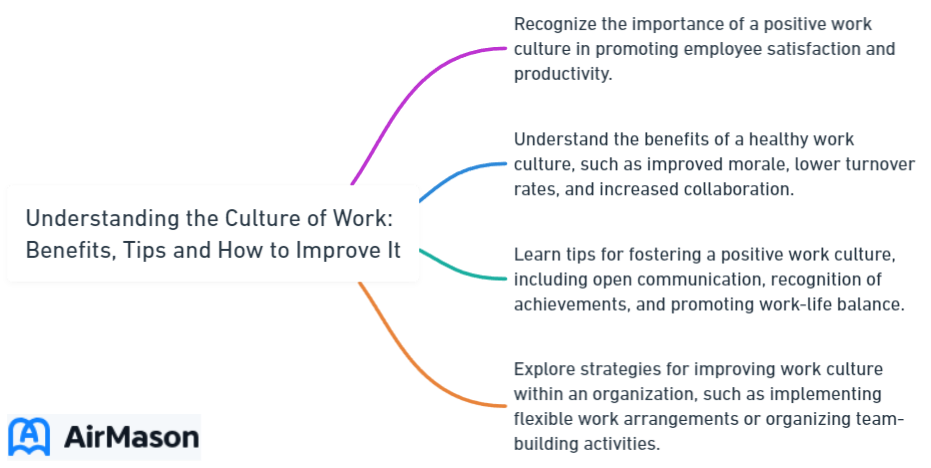
In today’s rapidly changing work environment, the importance of workplace culture has never been more apparent. With remote work becoming more prevalent and the need for organizations to adapt to the new normal, a strong, positive culture of work is essential for success. But what does it take to create a thriving work environment that fosters employee satisfaction, productivity, and overall business success?
In this comprehensive guide, we’ll explore the different aspects of the culture of work, discuss its importance, and uncover key strategies and practices for creating a healthy, positive work environment. Whether you’re a business leader or an employee looking to improve your organization’s culture of work, this blog post will provide valuable insights and inspiration to help you on your journey.
Key Takeaways
- Creating a positive workplace culture is essential for employee satisfaction, retention and overall business success.
- Strategies to improve workplace culture include setting clear goals & expectations, promoting work-life balance and recognizing employee achievements.
- Companies such as Google, Microsoft & Zappos have demonstrated successful workplace cultures, inspiring organizations to follow their example!
Defining Workplace Culture
Workplace culture, also known as organizational culture, company culture, or corporate culture, is the combination of shared values, beliefs, attitudes, and practices that shape an organization’s culture and work environment, ultimately defining the employee experience. Culture is one aspect that holds a company together and has a significant impact on various aspects of your organization’s culture, from employee satisfaction and retention to productivity and performance. In fact, nearly 40% of workers consider culture in the workplace “very important,” and 23% of job seekers list it as a top factor in their decision to accept a job offer.
An organization’s success heavily relies on fostering a positive workplace culture. A healthy culture can have a considerable positive effect on employees’ well-being, which in turn contributes to the organization’s success. Motivating teams and making organizations thrive is achievable by thoughtfully establishing core values, upholding them, and rolling out positive culture initiatives.

Values, Beliefs, and Attitudes
Values, beliefs, and attitudes serve as the foundation for how employees interact with each other and approach their work. They are the essential building blocks for creating an organization’s culture, shaping its decision-making processes, and guiding employee behavior.
For example, a clan culture emphasizes teamwork, workplace equality, mentorship, internal communications, apprenticeship, and one-on-one employee training. On the other hand, an adhocracy culture is renowned for its flexibility, agility, and innovation, making it an ideal fit for start-ups and tech businesses like Google and Apple.
Understanding the values, beliefs, and attitudes that guide your organization can help you create a workplace culture that fosters employee engagement, happiness, and success. Indeed, culture is important in achieving these goals.
Organizational Identity and Brand
The identity and brand of a company are instrumental in shaping its workplace culture. They shape how employees perceive the organization and its company values, providing a sense of purpose and identity that employees can relate to.
A strong brand identity can attract employees who share similar values and contribute to fulfilling the organization’s mission. Organizational leaders and management also play a vital role in managing and sustaining the desired culture.
Creating a unified and cohesive environment where employees feel connected, engaged, and motivated to contribute to the organization’s success is possible through the alignment of the organization’s identity, brand, and workplace culture.
Understanding an Organization’s Culture
An organization’s culture encompasses the shared values, beliefs, and norms that shape the way individuals within it interact and operate. It serves as the underlying fabric that guides decision-making, behavior, and the overall atmosphere within the workplace. An organization’s culture is not merely a superficial aspect; rather, it penetrates through every level, influencing everything from employee morale to strategic initiatives. It is the invisible force that unites employees towards a common mission and vision. A healthy organizational culture fosters a sense of belonging, encouraging employees to actively contribute and innovate, while a toxic culture can stifle creativity and hinder productivity. Recognizing and nurturing a positive culture is essential for any organization aiming for sustained success and a motivated workforce.
The Importance of Workplace Culture
Employee satisfaction, retention, productivity, and overall business success are all tied to a positive workplace culture. It conveys to customers whether they want to do business with a company and is a major factor in job seekers’ decisions to accept a job offer. Moreover, a healthy workplace culture can help your team achieve:
- Greater productivity
- Reduced turnover
- Increased employee engagement
- Unlocking the full potential of your employees
On the flip side, a poor work culture can have detrimental effects on employees and the organization as a whole. Employees who are physically and mentally stressed are not only less engaged but are also more likely to take time off and even leave the company, resulting in increased absenteeism and turnover. This can make it harder to find and retain quality employees, costing US employers an estimated $223 billion over a five-year period.
Employee Satisfaction and Retention
A healthy workplace culture:
- Attracts and retains top talent, reducing turnover costs
- Fosters employee loyalty
- Satisfied workers serve as brand ambassadors, sharing their positive work experiences with potential clients and future employees, which can be a great asset to your business.
A motivating workplace culture that boosts employee satisfaction, engagement, and retention can be created by setting clear goals and expectations, promoting work-life balance, and recognizing and rewarding employees. Implementing these strategies can help your organization build a strong, positive workplace culture that fosters employee loyalty and commitment to your company’s mission and values.
Productivity and Performance
A positive work environment boosts employee engagement, leading to increased productivity and better overall performance. Research shows that employees who are happy and content in their workplace are 13% more productive than those who are not. Unlocking the full potential of employees and driving the organization’s success can be achieved by fostering a workplace culture that promotes employee engagement and well-being.
Encouraging open communication, collaboration, and innovation can help your team members stay motivated and focused on achieving their goals, ultimately contributing to your organization’s growth and prosperity.
Cultural Change
Cultural change encompasses the transformation of societal norms, values, and behaviors over time. It is a dynamic process that reflects shifts in attitudes, beliefs, and practices within a particular community or society. This phenomenon can be driven by various factors, including technological advancements, globalization, and significant historical events. In today’s rapidly evolving world, cultural change is more prevalent than ever, with the influence of social media and interconnectedness playing pivotal roles. Embracing and adapting to cultural change is crucial for societies to thrive and remain relevant in an ever-changing global landscape. It necessitates open dialogue, empathy, and a willingness to learn from diverse perspectives, ultimately fostering a more inclusive and forward-thinking society.
Elements of a Healthy Workplace Culture

Key components of a healthy workplace culture include effective leadership, diversity and inclusion, and open communication and collaboration. These elements work together to create a positive work environment where employees feel valued, respected, and motivated to contribute to the organization’s success. By focusing on these critical aspects of workplace culture, organizations can build a strong foundation for employee satisfaction, engagement, and overall business success.
A thriving workplace culture that fosters employee happiness and well-being can be established through understanding and implementing these essential elements. By actively promoting and nurturing these components, you can build a positive work environment where employees feel empowered to reach their full potential and contribute to your organization’s success.
Leadership and Management
Strong leadership and management practices are essential for fostering a positive workplace culture, as they set the tone for employee behavior and expectations. Effective leaders not only define and uphold the organization’s core values but also serve as role models for employees, demonstrating the desired behaviors and attitudes.
Poor management, on the other hand, can lead to a toxic workplace culture, with 81% of employees who perceive their work culture as “poor” having witnessed a manager permitting others in the workplace “to get away with bad behavior”. By investing in leadership development and promoting positive management practices, organizations can create a healthy work environment that motivates, engages, and supports employees in achieving their goals.
Diversity and Inclusion

A diverse and inclusive work environment promotes creativity, innovation, and a sense of belonging among employees. By actively recruiting a diverse workforce, displaying inclusive signage, recognizing unconscious bias, and making necessary adjustments to hiring practices, organizations can foster a diverse and inclusive workplace that embraces all people, regardless of their race, gender, age, religion, sexual orientation, or other characteristics. This not only creates a positive work environment where employees feel valued and respected but also drives innovation and growth by bringing together diverse perspectives and ideas.
Communication and Collaboration
Open communication and collaboration are vital for building trust, respect, and a sense of teamwork within an organization. Encouraging honest and transparent dialogue among employees can help to foster a positive work culture where individuals feel heard and valued. By promoting a collaborative work environment, organizations can encourage employees to share ideas, solve problems together, and support one another in achieving their goals. This not only strengthens the workplace culture but also contributes to increased productivity, innovation, and overall success.
The Importance of a Positive Work Culture
Work culture plays a pivotal role in shaping the overall environment and dynamics within any organization. It encompasses the shared values, attitudes, and behaviors that define how employees interact and collaborate. A positive work culture fosters an atmosphere of trust, open communication, and mutual respect among team members. This environment encourages innovation, productivity, and a sense of belonging, ultimately leading to higher job satisfaction and retention rates. Moreover, a strong work culture attracts top talent, as prospective employees are drawn to organizations that prioritize their well-being and professional growth. In contrast, a negative work culture can lead to disengagement, high turnover rates, and diminished productivity, highlighting the critical importance of nurturing a healthy and supportive work environment.
Strategies for Improving Workplace Culture

Workplace culture can be enhanced by implementing strategies such as clearly defining goals, promoting work-life balance, and recognizing employee achievements. By focusing on these areas, organizations can create a more positive and motivating work environment that supports employee satisfaction, engagement, and overall success. Remember, the process of building a robust workplace culture is ongoing, demanding continuous effort, commitment, and adaptability.
While delving deeper into these strategies, consider their application within your own organization to foster a positive, supportive, and successful workplace culture. By implementing these practices, you can set the stage for improved employee well-being, satisfaction, and overall business success.
Setting Clear Goals and Expectations
Establishing clear goals and expectations helps employees understand their roles and responsibilities, fostering a sense of purpose and direction. To make sure clear goals and expectations are set, deadlines should be established, feedback provided, and measurable objectives defined.
This not only helps to maximize individual performance but also fosters cooperative teamwork, as employees understand how their work contributes to the organization’s overall objectives. By regularly communicating and updating goals and expectations, organizations can create a focused and driven work environment where employees feel motivated and empowered to succeed.
Promoting Work-Life Balance
Encouraging a healthy work-life balance can improve employee well-being, satisfaction, and productivity. Organizations can promote work-life balance by considering various types of work arrangements, such as:
- Implementing flexible work schedules
- Encouraging breaks
- Offering telecommuting options
- Providing access to mental health resources.
A positive work environment where employees feel refreshed, engaged, and more productive can be achieved by organizations that prioritize employee well-being and support a healthy work-life balance. This not only benefits the individual employee but also contributes to the organization’s overall success and growth.
Employee Recognition and Rewards
Recognizing and rewarding employee achievements can boost morale, motivation, and engagement. By celebrating individual and team successes, organizations can create a positive work culture where employees feel valued and appreciated for their contributions.
Implementing an employee recognition program, such as Etsy’s learning and engagement program, can help organizations acknowledge and reward employees for their professional development. By regularly recognizing and rewarding employees for their hard work and dedication, organizations can foster a supportive and inspiring work environment where employees feel motivated to achieve even greater heights.
Measuring and Evaluating Workplace Culture

Regularly assessing workplace culture through surveys and feedback can help organizations in the following ways:
- Identify areas for improvement
- Track progress
- Make data-driven decisions to enhance the work environment
- Better support employees
By gathering insights into the current state of their workplace culture, organizations can take proactive steps to create a positive and productive work environment.
For organizations aiming to stay competitive and continually improve their work environment, measuring and evaluating workplace culture is a vital practice.
As you consider the various strategies and practices shared in this blog post, remember that building a strong workplace culture is an ongoing journey. Regularly measuring and evaluating your workplace culture will help you:
- Identify areas for improvement
- Track your progress
- Ensure that you’re creating a positive work environment that supports the well-being and success of your employees.
Surveys and Feedback
Conducting surveys and gathering employee feedback can provide valuable insights into the current state of a company’s workplace culture. Surveys are structured questionnaires that allow you to collect data from employees, while feedback is more informal and can be gathered through conversations, employee recognition, and other methods.
By implementing both formal and informal feedback mechanisms, organizations can gain a comprehensive understanding of their workplace culture and identify areas for improvement. Some ways to gather feedback include:
- Conducting anonymous surveys
- Holding regular team meetings to discuss concerns and suggestions
- Encouraging one-on-one conversations between employees and managers
- Creating suggestion boxes or digital platforms for submitting feedback
Ensuring that the survey process is anonymous, straightforward, and transparent can help encourage honest and open feedback from employees, providing organizations with the insights they need to enhance their workplace culture and better support their team.
Assessing Employee Engagement
Evaluating employee engagement levels can help organizations identify areas where improvements are needed to foster a more positive work environment. Employee engagement is the emotional commitment an employee has to the organization and its goals, and it is associated with higher levels of productivity, performance, and job satisfaction.
By regularly assessing employee engagement through surveys, feedback, and other metrics, organizations can gain insights into the overall health of their workplace culture and make necessary adjustments to better support employee well-being, satisfaction, and success.
Case Studies: Companies with Strong Workplace Cultures

Examining successful companies with strong workplace cultures can provide valuable insights and inspiration for organizations looking to improve their own work environments. Companies like:
- Microsoft
- IBM
- HubSpot
- Zappos
- Warby Parker
- Southwest Airlines
- Chevron
- REI
Companies like Google, Apple, and Zappos are just a few examples of organizations that have built a strong positive company culture, which supports employee well-being, engagement, and overall success.
Organizations can foster a thriving workplace culture promoting employee happiness, well-being, and success, by learning from these inspiring examples and implementing the strategies and practices outlined in this blog post. Remember, building a strong workplace culture is an ongoing journey that requires continuous effort, commitment, and adaptability.
A positive work environment that supports the well-being and success of your employees and the entire organization can be established by putting the right strategies and practices into place.
Summary
In conclusion, creating a strong workplace culture is essential for employee satisfaction, retention, productivity, and overall business success. By understanding the different aspects of workplace culture, implementing key strategies and practices, and regularly measuring and evaluating your work environment, you can build a positive, supportive, and successful workplace culture that benefits both your employees and your organization.
As you embark on your journey to improve your workplace culture, remember that it is an ongoing process that requires continuous effort, commitment, and adaptability. By learning from successful companies with strong workplace cultures and implementing the insights shared in this blog post, you can create a thriving work environment that fosters employee happiness, well-being, and success.
Frequently Asked Questions
What is the culture of work?
Work culture is the shared values, attitudes, behaviors, and standards that make up a work environment and have a cumulative effect on workers and internal stakeholders. It aligns employee behaviors and company policies with the overall goals of the company while considering the well-being of individuals. Ultimately, it’s what creates the day-to-day experience at a company.
How do you answer work culture?
I believe a positive work culture is one that values open communication, teamwork, and mutual respect. It encourages employees to share their opinions and recognizes everyone’s contributions. By focusing on these qualities, I believe I can help create a successful work environment.
What is the role of leadership in creating a positive workplace culture?
Leadership is a fundamental element in creating a positive workplace culture, setting the standards and expectations for employees to follow. It is an essential part of creating a productive and successful workplace.
How can promoting work-life balance benefit employees and organizations?
Promoting work-life balance can significantly benefit both employees and organizations, leading to greater employee satisfaction, well-being, and productivity, which all contribute to organizational success.
How can organizations measure and evaluate their workplace culture?
Organizations can measure and evaluate their workplace culture through surveys and feedback, gaining valuable insights into the work environment and pinpointing areas for improvement.